Overview
This article examines how augmented reality (AR) significantly enhances customer engagement in the automotive industry through innovative marketing strategies and interactive experiences. Research indicates that AR applications, including virtual test drives and immersive configurators, not only improve customer interaction but also enhance decision-making and overall satisfaction. These advancements are transforming the purchasing journey and driving sales. By leveraging AR, automotive brands can create compelling experiences that resonate with consumers, ultimately leading to increased loyalty and higher conversion rates.
Introduction
Augmented reality (AR) is revolutionizing the automotive landscape, fundamentally transforming how brands engage with consumers and enhancing the overall customer experience. This innovative technology presents a unique opportunity for automotive companies to craft immersive interactions that captivate potential buyers, streamline the purchasing process, and forge deeper connections with their audiences.
However, as the industry embraces AR, it is essential to consider how these advancements not only elevate marketing strategies but also address the challenges of consumer expectations and technological integration.
What are the most effective methods through which AR can enhance customer engagement in the auto industry? Furthermore, how are leading brands leveraging this technology to distinguish themselves in a competitive market?
Magic Playbox: Transforming Automotive Marketing with Immersive AR Experiences
Magic Playbox stands at the forefront of the XR landscape, expertly crafting immersive AR experiences that resonate profoundly with automotive audiences. By seamlessly merging storytelling with cutting-edge technology, the studio empowers brands to forge unparalleled connections with clients, significantly enhancing marketing strategies and driving sales. Their initiatives frequently showcase interactive vehicle displays and virtual test drives, allowing potential buyers to engage with cars in a manner far more captivating than traditional methods permit. This innovative approach not only elevates client interaction but also aligns with the growing trend of augmented reality auto integration within the automotive industry, where engaging experiences are increasingly vital for effective marketing and client engagement.
BMW Group: Enhancing Customer Experience with Augmented Reality in the iX
The BMW Group has revolutionized the user experience through the strategic introduction of augmented reality in the iX model. This innovative approach empowers potential buyers to visualize the vehicle within their own environments using AR technology. By simply pointing their smartphones at a designated area, users can observe a life-sized model of the iX, complete with customizable options. This engaging interaction not only enhances the purchasing journey but also facilitates informed decision-making by enabling individuals to visualize their preferences in real-time.
As augmented reality auto technology continues to gain traction, its integration into the automotive sales process has become increasingly vital, significantly enhancing client engagement and satisfaction. Research indicates that such advancements are not merely enhancements; they represent a shift in how consumers interact with automotive brands, fostering deeper connections and driving sales.
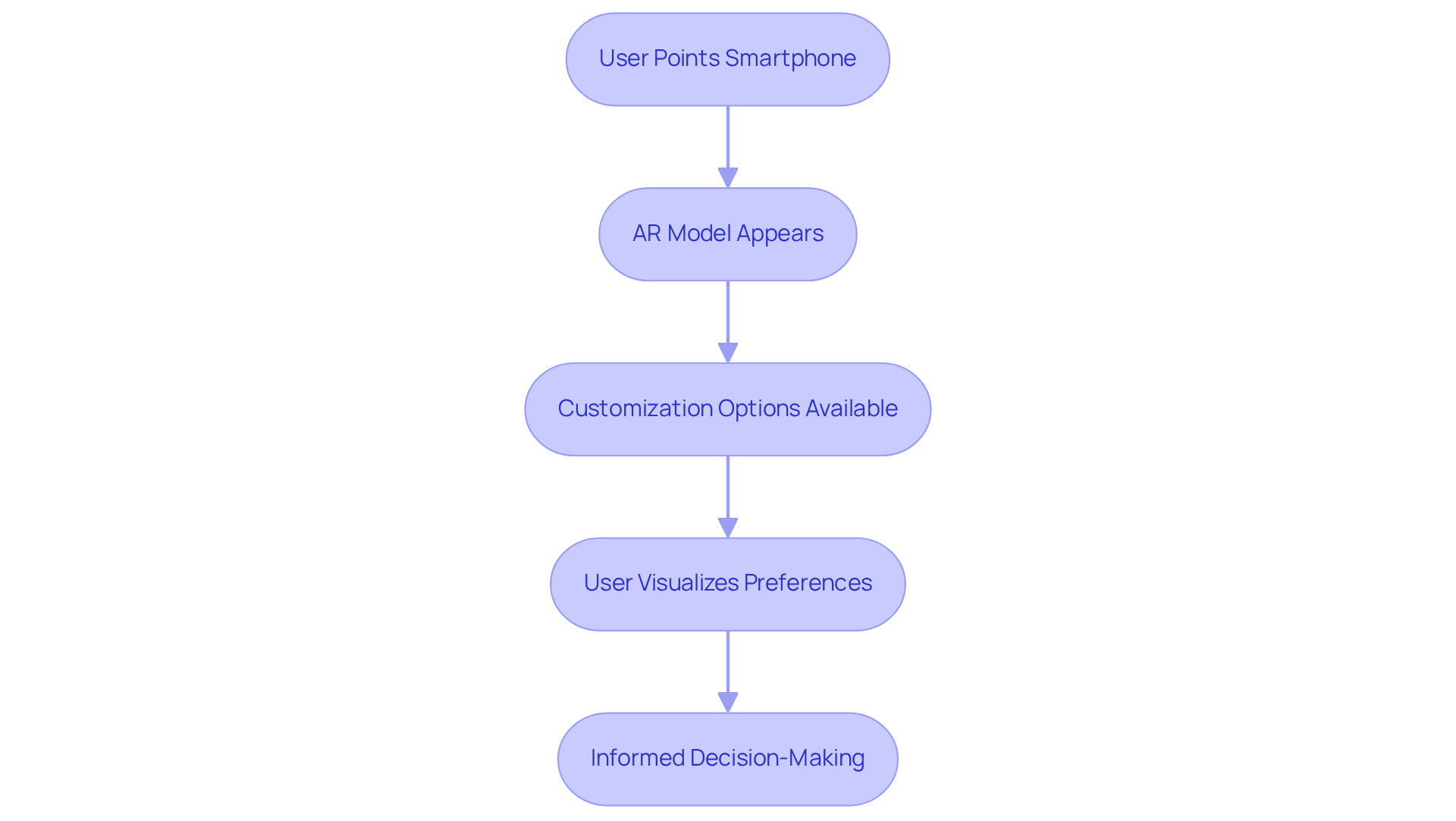
Fiat Chrysler Automobiles: Immersive AR Car Configurator for Enhanced Customer Interaction
Fiat Chrysler Automobiles has pioneered an immersive augmented reality auto configurator that revolutionizes the customization experience. This groundbreaking tool, employing Project Tango technology, enables users to create and visualize their ideal automobiles in a virtual space. By facilitating real-time modifications of features such as color, wheels, and interior selections, it significantly enhances engagement. This dynamic platform effectively reduces the uncertainty often associated with purchasing a vehicle, leading to improved client satisfaction.
Research indicates that immersive AR interactions can result in higher sales, as clients feel more assured in their decisions. Notably, users typically visit car configurator webpages 1 to 6 months prior to making a purchase, underscoring the critical role these tools play in the buying journey. This innovative approach not only transforms the car purchasing experience but also positions Fiat Chrysler as a frontrunner in utilizing AR technology to enhance client interaction within the automotive sector.
Furthermore, each project is assigned a dedicated account manager, ensuring clear communication and support throughout the customization process, which further elevates overall customer satisfaction.
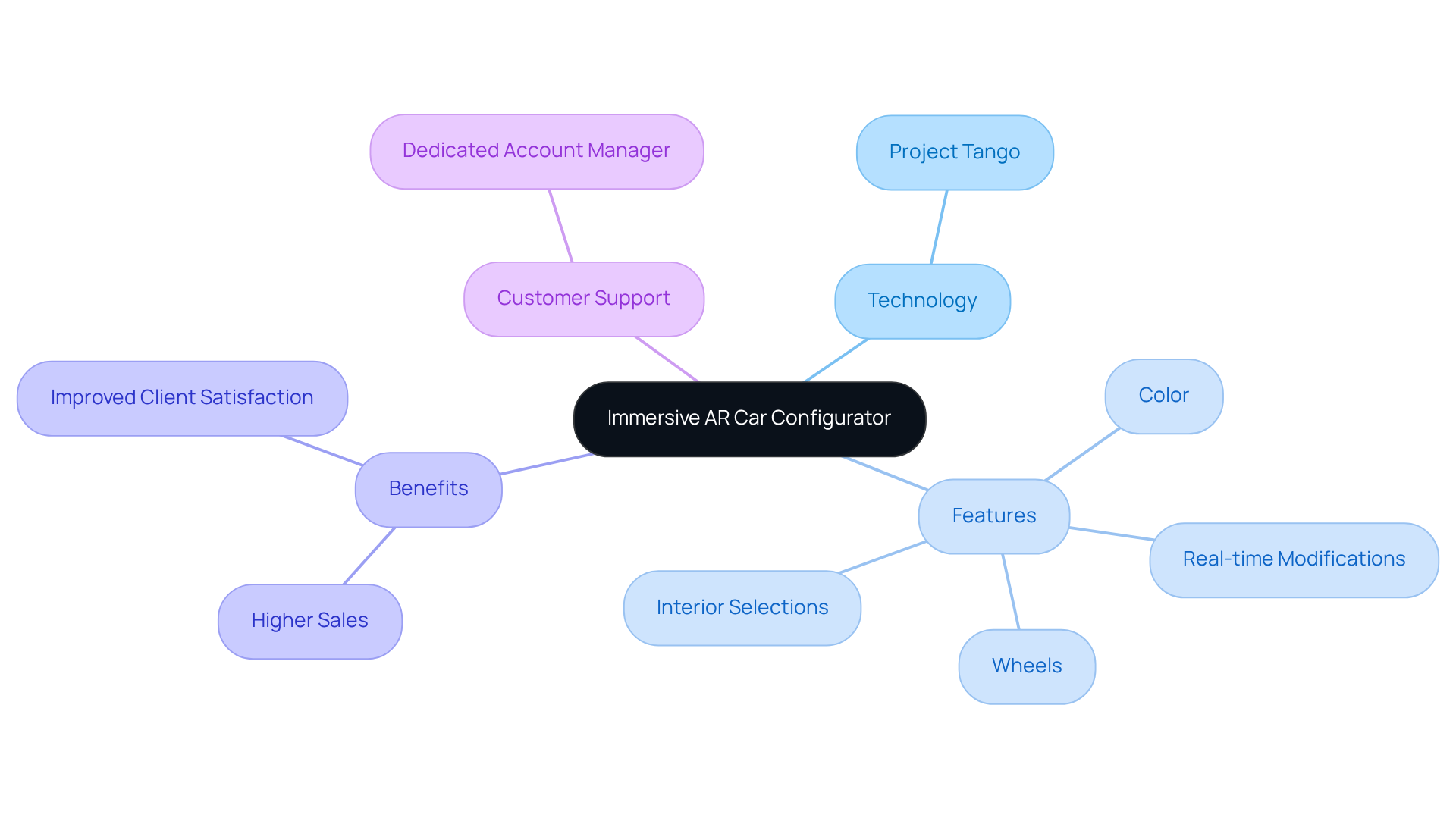
Honda: Showcasing New Models with HondaLens Augmented Reality at Auto Shows
Honda has strategically integrated augmented reality into its marketing initiatives through the HondaLens presentation, which debuted at auto shows to showcase new models. This immersive AR application captivates participants, allowing them to engage with virtual representations of vehicles. Detailed visualizations and information significantly enhance the overall experience.
By leveraging augmented reality auto, Honda not only captivates audiences but also effectively communicates the features and benefits of its latest models, leaving a lasting impression on potential buyers. This approach aligns with the growing consumer demand for interactive engagements; research indicates that 66% of consumers in Japan express a desire for AR in offline stores, reflecting a broader trend that Honda is skillfully tapping into at auto shows.
Furthermore, augmented reality auto has been proven to enhance consumer confidence and satisfaction, with 57% of users more likely to support brands that provide such interactions—a trend that Honda's groundbreaking augmented reality auto initiatives directly address. The HondaLens feature allows users to interact with the vehicle, uncovering six concealed stories triggered by user movement, thereby enriching the interaction.
Honda's innovative application of AR not only enhances brand perception but also positions the company as a leader in automotive marketing, effectively engaging clients in a memorable way. This aligns with the objectives of companies like Magic Playbox, which focus on innovating immersive AR interactions that enhance brand involvement and client loyalty.
As Tim Cook aptly noted, "Engagements with AR will become everyday events," underscoring the transformative potential of AR in enhancing customer interactions.
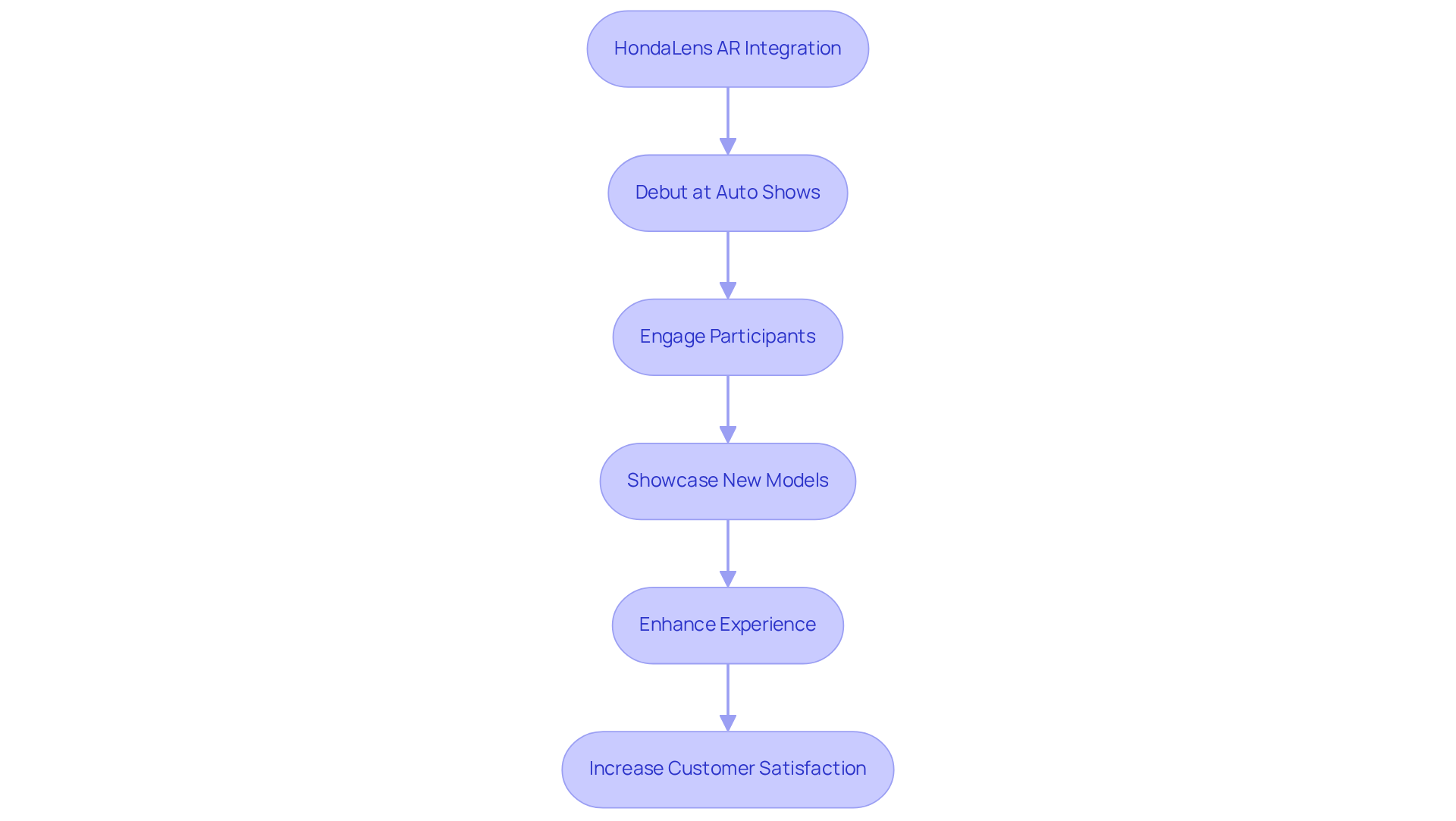
USAA: Streamlining Car Buying with an Augmented Reality Application
USAA has launched an augmented reality auto application that revolutionizes the car buying experience for its members. By utilizing augmented reality auto technology, users can effortlessly point their mobile devices at automobiles to instantly obtain detailed information about pricing, availability, and features. This innovative solution streamlines the purchasing process through augmented reality auto by eliminating manual data entry and empowering customers with essential knowledge that enables informed decision-making.
As Heather Pollard, vice-president of USAA Auto Experience, aptly noted, 'Trends show that consumers are increasingly using digital channels to complete the entire car-buying process, including augmented reality auto features.' This observation reflects a growing trend in the car market, where augmented reality auto technology is currently limited to luxury vehicles, affecting accessibility and affordability.
The complete interaction is significantly improved, aligning with the anticipated expansion of the global augmented reality auto sector, which was valued at USD 3.97 billion in 2020 and is predicted to grow further. Additionally, USAA's app is currently in a pilot phase, incorporating augmented reality auto features to allow for user feedback that will refine the application, ultimately enhancing the car-buying journey.
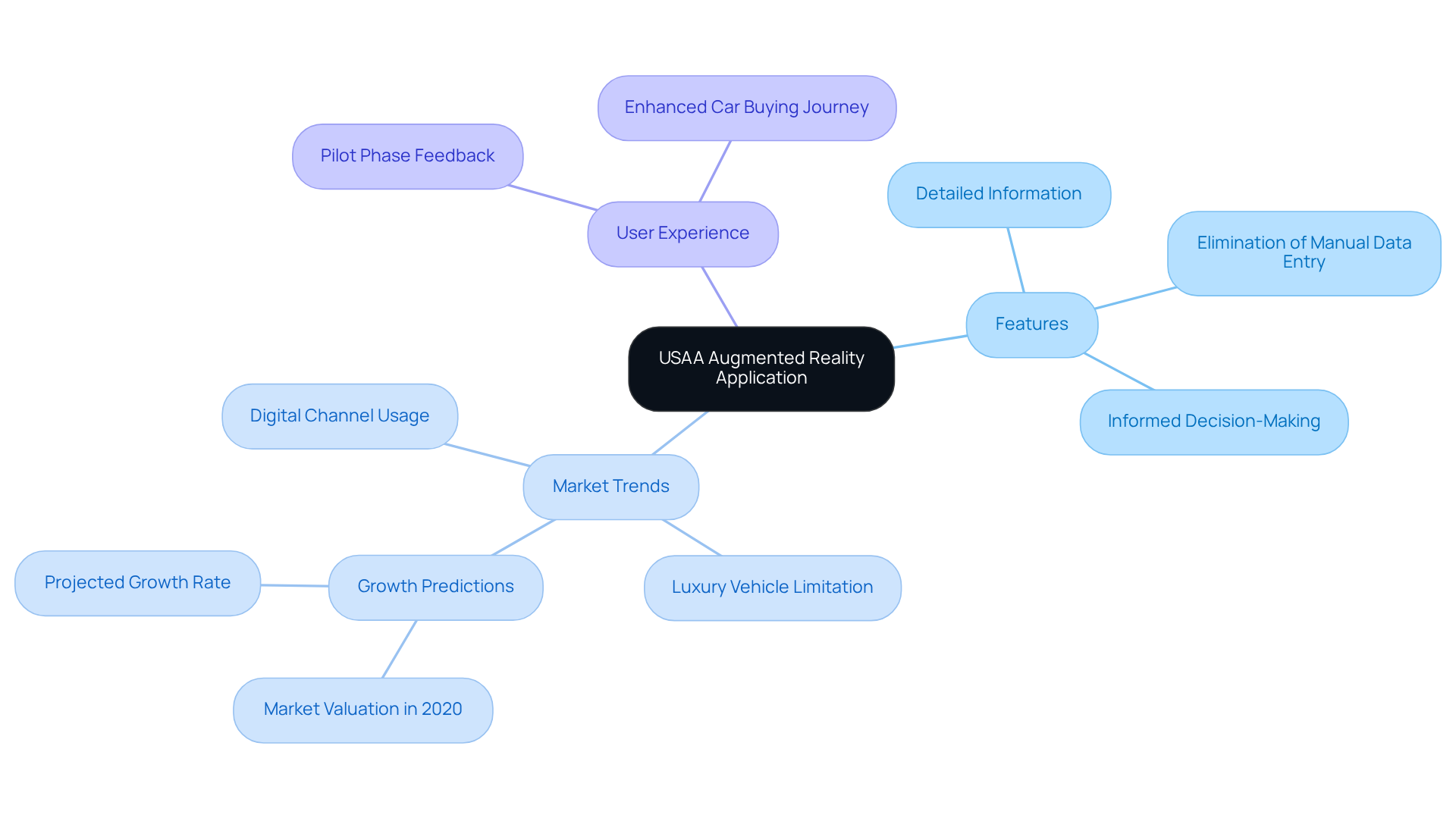
Basemark: Delivering Augmented Reality Experiences for Premium Automotive Brands
Basemark excels in creating augmented reality auto solutions specifically tailored for high-end vehicle brands. Their innovative solutions significantly enhance client interaction by delivering interactive visualizations and real-time data overlays that improve user satisfaction.
Through strategic partnerships with leading automotive producers, Basemark crafts immersive environments where customers can dynamically explore the features and specifications of vehicles. For instance, the integration of augmented reality auto applications in the BMW Group's new electric iX models has revolutionized navigation by displaying upcoming maneuvers and lane suggestions directly on the Central Information Display, thus enhancing the driving experience.
This groundbreaking approach not only captivates potential buyers but also fosters a deeper emotional connection with the brand, ultimately driving higher engagement and increasing purchase intent.
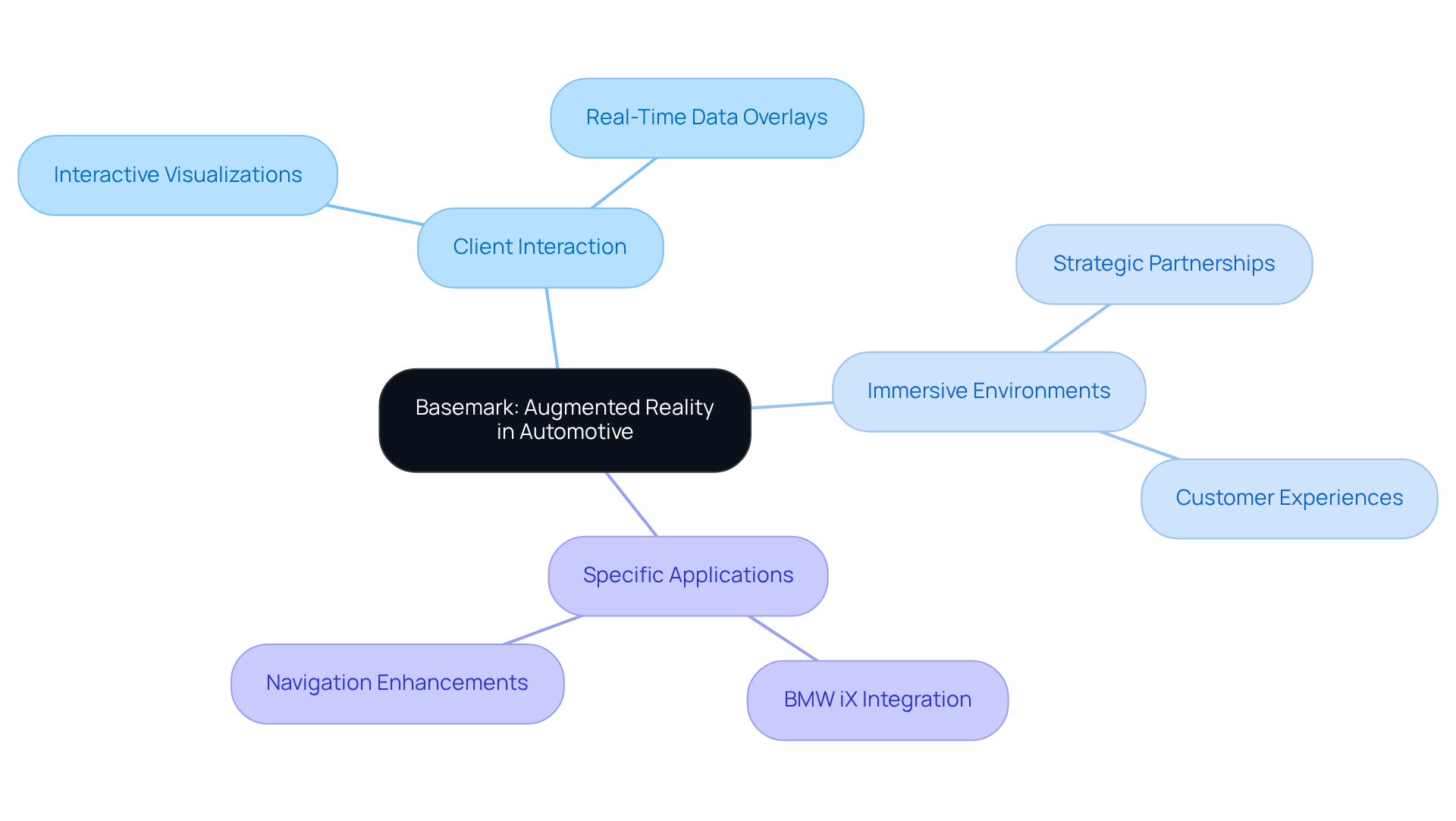
Fleet Maintenance: Utilizing Augmented Reality for Efficient Vehicle Maintenance
Augmented reality auto is revolutionizing fleet maintenance by equipping technicians with real-time, interactive support for repairs and diagnostics. Augmented reality auto applications empower maintenance personnel to visualize intricate systems and adhere to step-by-step instructions, significantly minimizing downtime—an essential consideration given that unexpected maintenance costs can be three to nine times higher than scheduled servicing.
This technology, such as augmented reality auto, not only enhances the accuracy of repairs but also streamlines training processes for new technicians, cultivating a more skilled workforce. For example, BMW's implementation of augmented reality auto techniques has shown effectiveness in complex maintenance tasks, utilizing markerless CAD-based models to facilitate repairs.
Similarly, Bosch's initiatives using augmented reality auto for training have reduced task completion times by 15%, underscoring the potential of augmented reality auto to boost service efficiency and curtail maintenance expenses. By bridging knowledge gaps and providing engaging training opportunities, the augmented reality auto technology is setting a new standard in maintenance, ultimately leading to improved repair efficiency and reduced operational costs.
Furthermore, the use of augmented reality auto allows for overlays of predictions regarding potential equipment failures, enabling proactive intervention and enhancing overall operational efficiency.
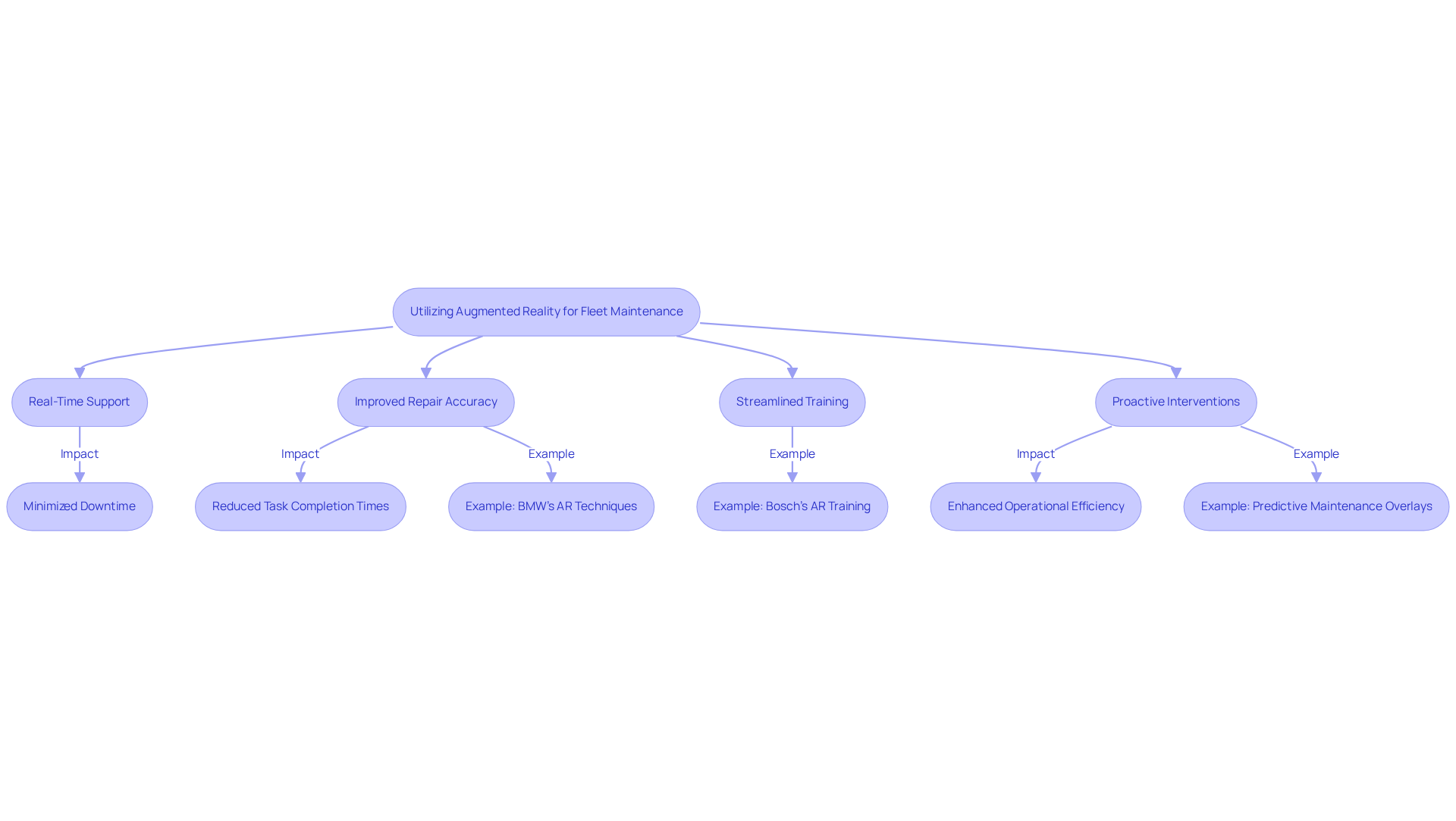
Magic Kids: Enhancing Automotive Education Through Augmented Reality
Magic Kids, an innovative initiative by Magic Playbox, utilizes augmented reality auto to provide captivating educational experiences for children fascinated by vehicles. Through interactive games and activities, children delve into vehicle mechanics, safety protocols, and the importance of regular maintenance in a dynamic and immersive way. This pioneering approach utilizing augmented reality auto not only entertains but also fosters a profound understanding of automotive concepts, motivating the next generation to explore careers in the automotive industry.
By transforming learning into an enjoyable and interactive endeavor, augmented reality auto effectively bridges the divide between theoretical knowledge and practical application, thereby enhancing retention and comprehension of complex subjects. As the global augmented reality in education market is projected to reach US$ 55.84 billion by 2033, the potential for AR to revolutionize learning interactions is immense.
Furthermore, integrating AR modules can elevate sales by up to 80%, underscoring its effectiveness in engaging users. As industry experts assert, 'AR provides a more engaging and successful learning experience compared to traditional methods, enhancing information retention.'
Despite the challenges educational institutions encounter in sourcing compatible AR tools, Magic Kids distinguishes itself by offering customized solutions that meet these critical needs.
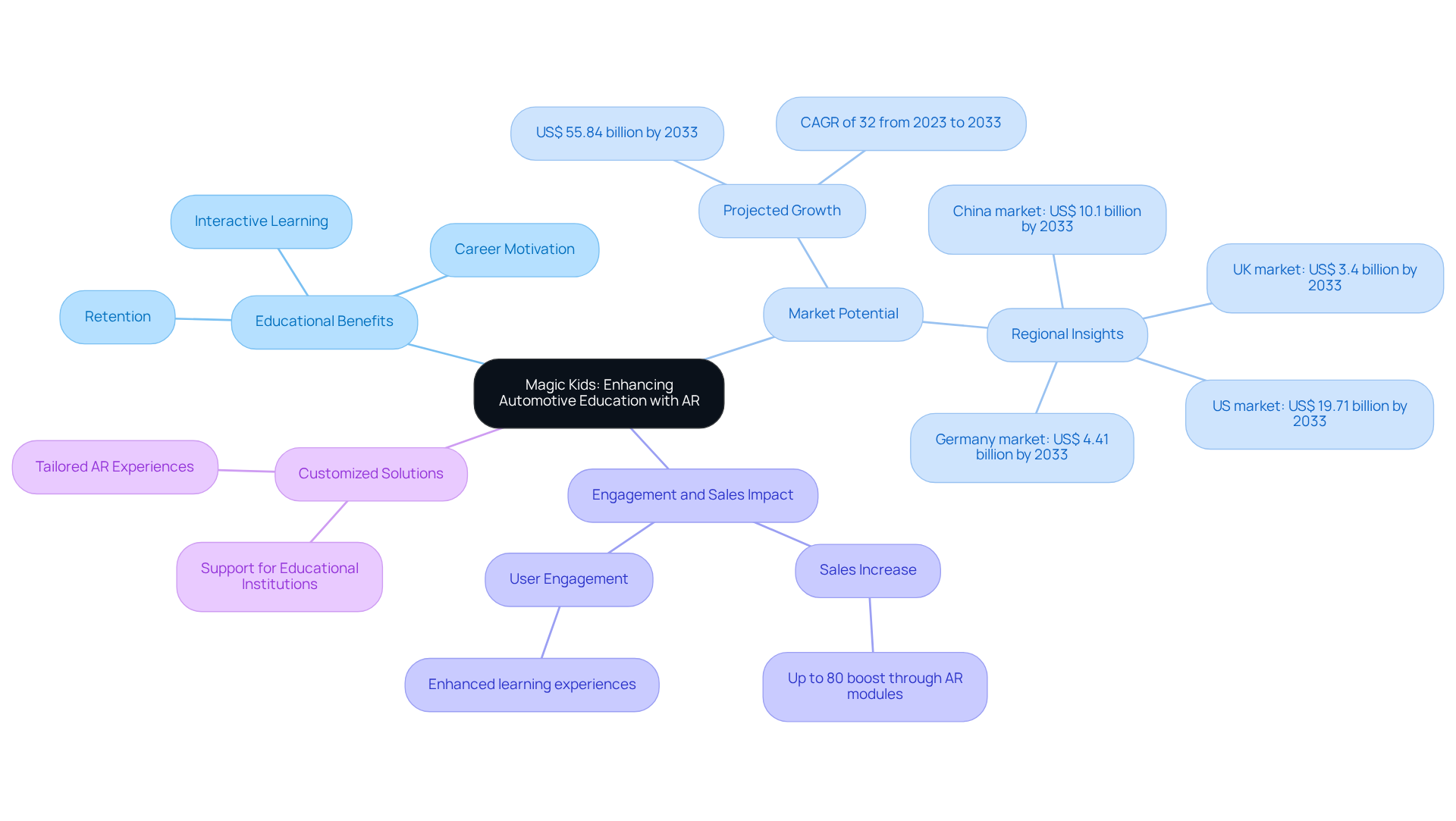
Research Insights: Augmented Reality for Safer Pedestrian-Vehicle Interactions
Recent research indicates that augmented reality (AR) can play a crucial role in enhancing safety during pedestrian-vehicle interactions. By providing visual cues and alerts to both drivers and pedestrians, AR technology can significantly reduce accidents and improve awareness of surrounding traffic conditions. This innovative application of AR not only benefits individual users but also enhances overall road safety. It serves as a valuable tool for vehicle manufacturers and city planners alike, underscoring the need for collaboration in implementing these proven strategies.
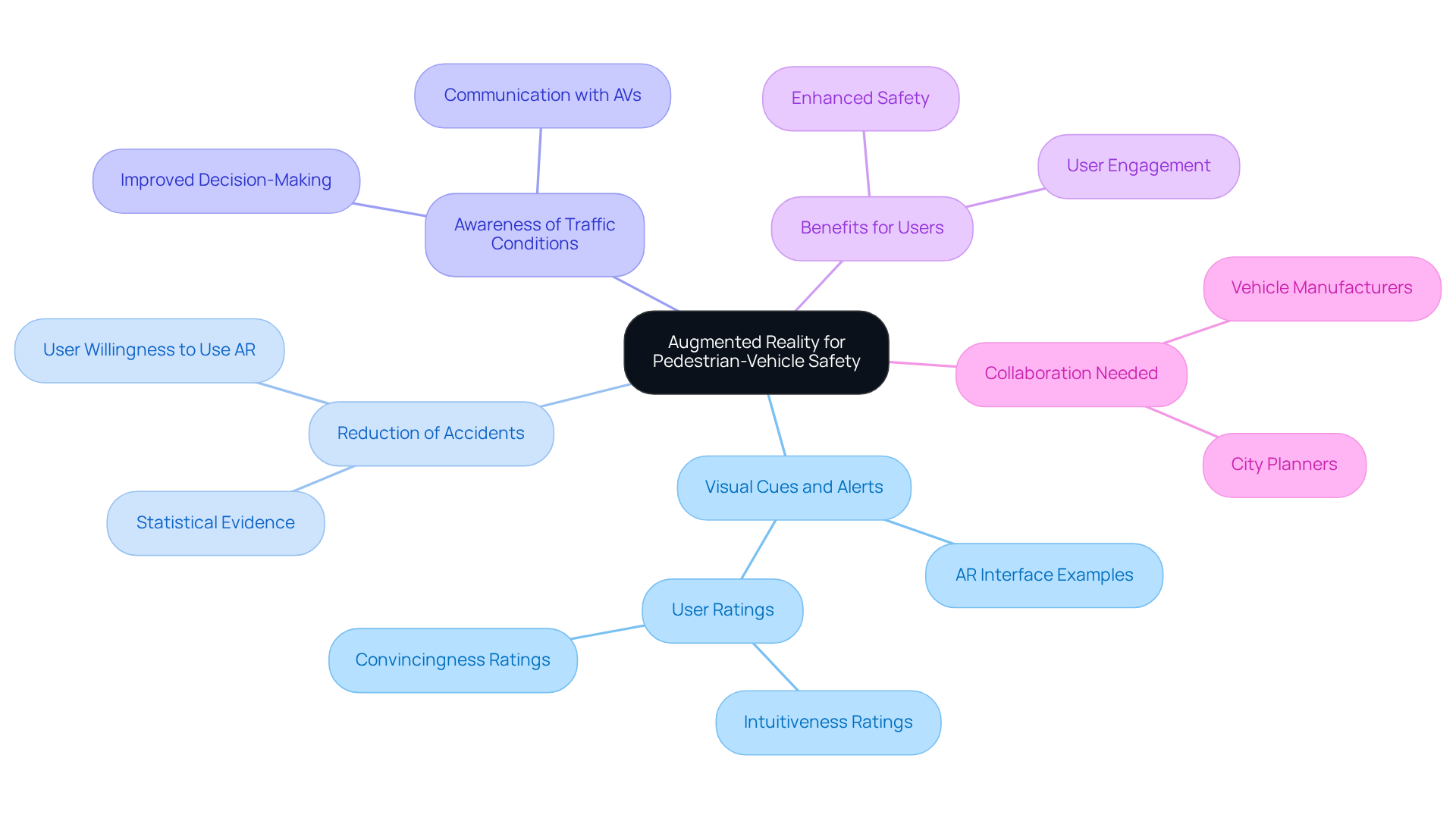
Future Trends: The Evolving Role of Augmented Reality in the Automotive Industry
The future of augmented reality (AR) in the transportation sector is not just promising; it is transformative. Swift technological progress is set to enhance AR's integration into design, sales, and maintenance. Key trends include:
- The implementation of augmented reality auto for improved navigation systems, which offer real-time hazard detection and route guidance.
- The rise of virtual showrooms that allow customers to explore and personalize automobiles from the comfort of their homes.
These innovations streamline the car-buying process and create personalized experiences that resonate with consumers, contributing to the projected growth of the augmented reality auto market.
As AR technology advances, augmented reality auto will increasingly influence how consumers engage with their vehicles, enhancing involvement and effectiveness throughout the ownership experience. For instance, AR applications simplify complex vehicle features, enabling users to receive interactive explanations through their smartphones. This approach reduces decision anxiety, allowing buyers to visualize how a car fits into their lifestyle before making a purchase. Users can point their smartphones at dashboards to receive instant overlays that explain functions, making the technology's impact more tangible.
Magic Playbox, a pioneer in XR solutions, is at the forefront of these advancements, offering immersive interactions through augmented reality auto that enhance customer involvement in the car industry. Case studies underscore the transformative impact of AR in automotive design and sales. For example, Ford utilizes VR simulations to enhance ergonomics and user experience, significantly decreasing development time and material waste. Similarly, dealerships are adopting augmented reality auto virtual showrooms that not only improve user engagement but also simplify the decision-making process by enabling buyers to customize vehicles remotely. This practical application illustrates the benefits of AR technology in real-world scenarios.
The integration of augmented reality auto technologies is not merely a trend; it signifies a fundamental shift in the vehicle industry. As more brands recognize the potential of augmented reality auto to enhance customer interactions and improve sales processes, the automotive industry is poised for a revolution that prioritizes immersive, engaging experiences for consumers. However, challenges such as high development costs and data privacy concerns must also be addressed to fully realize AR's potential. Research indicates that over 80% of consumers who try AR are more likely to purchase a product, clearly demonstrating the effectiveness of AR in boosting consumer confidence and sales.
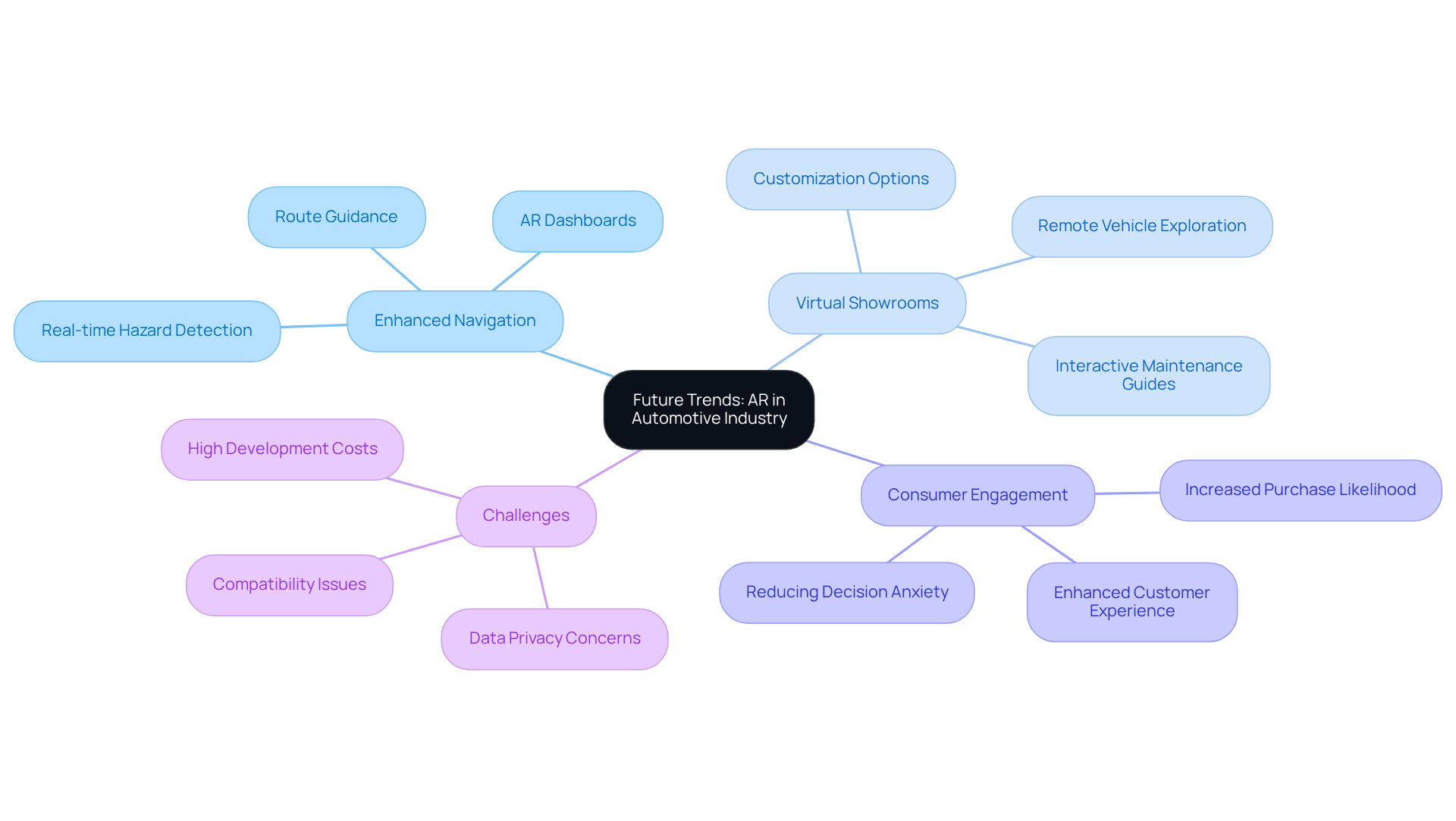
Conclusion
The integration of augmented reality (AR) into the automotive industry is not merely a trend; it is a pivotal force reshaping customer engagement and transforming the way consumers interact with vehicles. By leveraging immersive AR experiences, brands can craft captivating and personalized interactions that significantly enhance the purchasing journey. This evolution in marketing strategies not only fosters deeper connections between consumers and automotive brands but also drives sales and elevates customer satisfaction.
Throughout this discourse, various industry leaders have demonstrated the profound impact of AR on customer engagement. For instance:
- BMW's innovative visualization tools enable potential buyers to explore customizable options in real-time.
- Fiat Chrysler's immersive configurator simplifies the car customization process.
- Honda's AR initiatives at auto shows enhance engagement.
- USAA's application streamlines the car-buying experience.
These examples illustrate a clear trend toward enhanced interactivity. Furthermore, the growing importance of AR in creating memorable and effective customer interactions is evident.
As the automotive industry continues to embrace augmented reality, it is imperative for brands to recognize and adapt to these emerging trends. The potential for AR to not only enhance user experience but also improve safety and operational efficiency presents a compelling case for its widespread adoption. By investing in AR technologies, automotive companies can position themselves at the forefront of innovation, ensuring they meet the evolving demands of consumers and drive the future of vehicle engagement.
Frequently Asked Questions
What is Magic Playbox and what does it offer in automotive marketing?
Magic Playbox is a studio specializing in immersive augmented reality (AR) experiences for the automotive industry. It combines storytelling with advanced technology to help brands create strong connections with clients, enhancing marketing strategies and driving sales through interactive vehicle displays and virtual test drives.
How does the BMW Group utilize augmented reality in the iX model?
The BMW Group enhances customer experience by integrating augmented reality in the iX model, allowing potential buyers to visualize the vehicle in their own environments. By pointing their smartphones at a designated area, users can see a life-sized model of the iX with customizable options, improving the purchasing journey and aiding informed decision-making.
What is the purpose of Fiat Chrysler Automobiles' immersive AR car configurator?
Fiat Chrysler Automobiles has developed an immersive AR car configurator that allows users to customize and visualize their ideal vehicles in a virtual space. This tool enables real-time modifications to features like color and interior selections, enhancing customer engagement and reducing uncertainty in the purchasing process.
How do immersive AR experiences impact customer satisfaction and sales?
Research indicates that immersive AR interactions can lead to higher sales as customers feel more confident in their decisions. These experiences significantly improve client satisfaction by facilitating a more engaging and informed purchasing journey.
What role does a dedicated account manager play in Fiat Chrysler's AR configurator experience?
Each project in Fiat Chrysler's AR configurator is assigned a dedicated account manager to ensure clear communication and support throughout the customization process, which enhances overall customer satisfaction.




